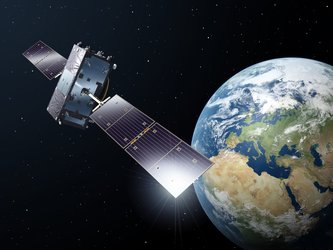Galileo satellites encapsulated for launch
Europe’s latest Galileo satellites have been sealed within their launch fairing, atop the Fregat upper stage that will carry them into their final orbit.
The two Galileo satellites had been attached together on the dispenser that secures them during flight then delivers them into their final orbit on 21 August.
Then 14 August saw the follow-on installation of the stack – the two satellites plus dispenser – onto the Fregat stage.
The following day was the last time the two Galileo satellites were seen by human eyes, as the two halves of the protective launch fairing were sealed around the satellites and their upper stage.
Meanwhile on 18 August, the satellites’ three-stage Soyuz launcher was moved by rail onto its launch pad then lifted to the vertical position.

The launcher’s mobile gantry was then moved into position around the upright launcher. This allows the next step of the launch campaign to take place, the hoisting up and attachment of the entire ‘upper composite’ – the launch fairing containing the Galileo satellites, their dispenser and the Fregat fourth stage.
At three hours, 47 minutes and 57 seconds after liftoff, the satellites will then be deployed from their Fregat by the dispenser’s pyrotechnic separation system once their final 23 500 km altitude is reached.

These new satellites will join four Galileo satellites already in orbit, launched in October 2011 and October 2012 respectively.
This first quartet were ‘In-Orbit Validation’ satellites, serving to demonstrate the Galileo system would function as planned.
Now that work has been done, the ‘Full Operational Capability’ satellites being launched on Thursday are significant as the first of the rest of the Galileo constellation.
The payloads generating navigation signals to Earth have been manufactured by Surrey Satellite Technology Ltd in the UK, while the satellites carrying them have been built by OHB in Germany.

A steady stream of launches is planned for the next few years, with two Galileo satellites flown per Soyuz launch and four Galileo satellites flown per launch of an Ariane 5 variant currently in preparation.
Galileo partners
The definition, development and In-Orbit Validation phases of the Galileo programme were carried out by ESA and co-funded by ESA and the EU.
The Full Operational Capability phase is managed and fully funded by the European Commission. The Commission and ESA have signed a delegation agreement by which ESA acts as design and procurement agent on behalf of the Commission.















 Germany
Germany
 Austria
Austria
 Belgium
Belgium
 Denmark
Denmark
 Spain
Spain
 Estonia
Estonia
 Finland
Finland
 France
France
 Greece
Greece
 Hungary
Hungary
 Ireland
Ireland
 Italy
Italy
 Luxembourg
Luxembourg
 Norway
Norway
 The Netherlands
The Netherlands
 Poland
Poland
 Portugal
Portugal
 Czechia
Czechia
 Romania
Romania
 United Kingdom
United Kingdom
 Slovenia
Slovenia
 Sweden
Sweden
 Switzerland
Switzerland


























